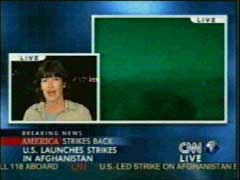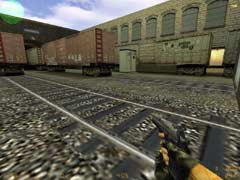 |
||||||||||||||||
 |
||||||||||||||||
 |
||||||||||||||||
 |
||||||||||||||||
|
||||||||||||||||
 |
||||||||||||||||
 |
Layers of Realities | ...what
I am calling machinic vision. |
|
|||||||||||||
Just keeping in mind that all what ever is beeing transmitted in digital distribution is a pur signal. In information theoretic terms Katherina N. Hayles explains, no message is sent at all. The transmitted information has no dimensions, no materiality and no bnecessary connection with meaning. This correspondence of the unfinished form of the digital is one of the crucial factors of the new developments. |
||||||||||||||||
| ...
a machinic assemblage of images in a state of universal variation
in which priviledged instances of subjective perception are always
subsumed in a mobile constellation of relationship with other images.
... (J.Johnston in 'Machinic Vision') |
||||||||||||||||
| The 'too real' of synthetic
images, - so artists like Thomas Demand are already adopting this
in their work. (see)
|
Images, which still demand the claim to show part of our surrounding reality are becoming increasingly abstract, as already mentioned. So to be still taken as an index of reality today they take up various strategies of verification. Most common is the 'scientific variant' coming together with professional explanations. Other ones, especially used in TV and internet is the layering with icons, emblems, texts, scrollers and so on. Sometimes it even seems now, that the missing of images or low quality has already been taken up as a mainstream strategy. The most famous of those are probably the Usama bin Laden videos, layered with icons or text by everyone who wanted to make use out of it. So there are various different possibilities to read - in the end in every direction. |
|||||||||||||||
 |
A message has
an information content specified by a probability function, it is
a pattern, not a presence. An entire encoding is needed to transform
the transfered signals into the assumed material or virtual form.
In this sense now images become exactly the same as any other information
within the electronic translation systems, eventhough the output can
take very different forms. Digitally the image is encoded to a grid of cells, now a composition of discrete pixels that have assigned mathematical values. By this the photographic and cinematic image is freed from its carrier material and is straight away recoded to algorythm. This allows recomposition as well as instantaneous transmission within a machinic assemblage of images. The very essential distinctions of the digital, its unfinished form, allows that discourses, images and practises from various geogrphical and historical situations can be easily patched together. So it not only can happen that users run across different instantiations of distinct things that go under the same names. This is also the reason for a reappearance of various symbols, signs or texts like naturally in very different contexts. |
|||||||||||||||
| So what to show, when nothing
at all should be seen? At least one can layer the non existing information
with different signs. ( |
||||||||||||||||
 |
These are no direct links as the mentioned can be seen in daily media, but you can go for a few examples on media coverage from different points of view. see the taz1 going in both directions taz2 or read just some other voices then the used and already cited ones: medienanalyse-international something on CNN something on Al Jazeera not longer possible but the same article is still accessible at: electronic intifada |
|||||||||||||||
| An other method, with almost
the same content, is to show any image, if it has some mark (here
timecode) on it, it will work. (spiegel
online; cover |
||||||||||||||||

|
Digitized information
allows to be manipulated distinctly by each user, as it can be downloaded,
can be shown within the systems of various devices and so on. Therefore digital data does not reproduce, but rewrite its content, there is also alteration due to comprehension,degradation, as well as the easily possible modification of data, affecting the pixels for the image depiction - all is conceptually happening on the same level, of the digital basis. The character of inherent manipulation or fiction of images today, and as well their non-readability (or readability in every direction / flickering signifier) and their loss of contextuality are giving way to different strategies of presentations. Structures of recontextalisations, repetitions, and interpretations of rhetoric and performative aspects are increasingly refered to in the presentation of images. |
In contrary to that the composed virtual imaginery of virtual reality becomes seemingly the more like a natural picture, i.e. the more realistic - this means the less abstract it looks. Also L.Manovich points out, that most of the synthetic images are more realistic than traditional photographs. In fact they are too real. But this has seemingly not much influence on our perception as real, because so we have come to believe in the film-based image we are easily convinced that because it looks real, it can be it. |
||||||||||||||
| In the synthetic
world we are already used to layering therefore we long for the utmost
realistic sight of every small thing. |
||||||||||||||||
 |
||||||||||||||||
|
Finding the Right Balance: Simulator and Live Training for Navy Units play or go online planning or come to active worlds |
||||||||||||||||
| The foregrounded layering for any opinion has become a very common strategy. | ||||||||||||||||
| s* - spiegel
articles no longer free accessible /02/2004 |
||||||||||||||||
 |
||||||||||||||||
 |
||||||||||||||||
